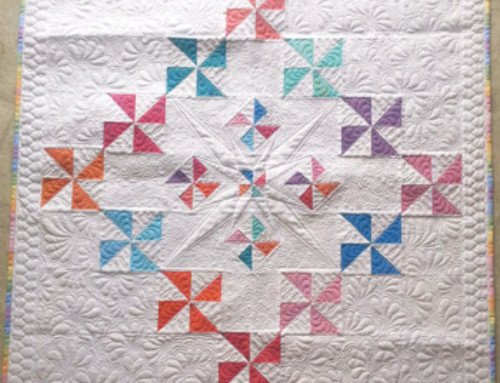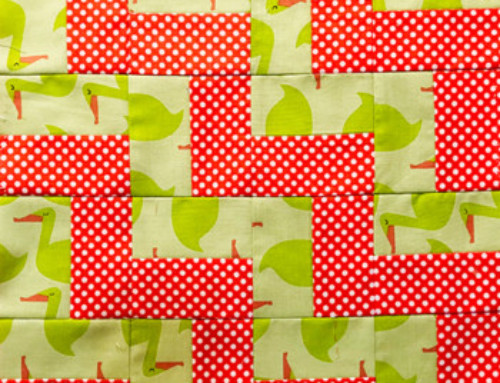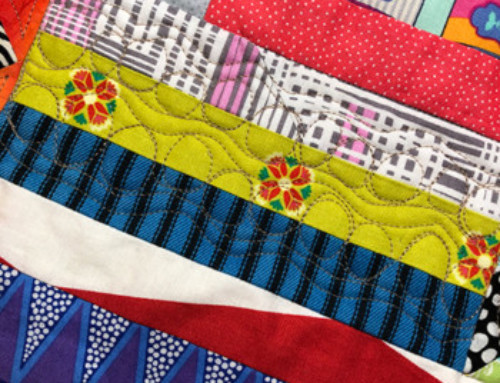By Mary Beth Krapil, Handi Quilter National Educator
The top is finished and the backing has been pulled together. Now we’re ready for the best part, the quilting. But we have to have something in the middle to make it into a quilt. I have some thoughts on batting that I’d like to share. It’s the least appreciated part of the quilt. But it does most of the work of making a quilt either soft and warm and cuddly, or wall hanging worthy. So you have to choose wisely.

What is batting?
Batting is the material used between the top and backing layers of fabric in a quilt. This material provides dimension, texture and loft to your quilt as well as providing an insulting layer of warmth.
Batting can be made from many different fibers. The most popular among quilters are cotton, wool, silk, polyester, bamboo, and various blends. You can find a nice description of the different fibers at the Connecting Threads website.
There are a lot of choices on the market and it may seem overwhelming, but it really boils down to two things: 1. how the quilt will be used and 2. your personal preferences. I’m going to share my preferences and give my reasons. You should experiment and decide on your own personal preferences with some of what you read here in mind.
How will this quilt be used?
We make all sorts of quilted items, wall hangings, art quilts, table runners, place mats, baby quilts, kid’s quilts, couch quilts, bed quilts, lap quilts, heirloom quilts, guest bed quilts, don’t-you-dare-nap-on this-quilt quilts, picnic quilts, car quilts, dog bed quilts. I’m starting to feel like Forrest Gump’s friend, Bubba, listing the uses for shrimp, but I’m sure you’re getting the picture.
I divide up my projects into two categories:
1. Flat and stable
Wall Hanging
In this category I include any quilt that needs to remain flat and square, so that it hangs nicely, and will very seldom (if ever) get washed. This type of quilt requires a stable batting that will not sag if hung on the wall, that doesn’t stretch as much as some other batts, and that provides stability. My choices are cotton, or an 80/20 cotton/polyester blend.

There’s only one problem with those choices, they don’t usually have much loft. I’m a quilter and I want my quilting texture to show. For that you need loft. Loft refers to the thickness or puffiness of batting. So to add that loft without giving up stability, I add another layer, of wool or polyester, on top of my flat stable layer. It lets my quilting texture sing while the cotton layer against the backing keeps everything flat and square. Win-win!
Table runners and Place Mats
These are things that will get washed. And they need to lay flat so that you can place dishes and glasses and such on them and not have anything tip over. My choice for these is fusible fleece. I position the fusible side to the backing so that I can get a small degree of texture from the quilting on the top. After quilting and binding I give the item a good press (according to fleece package directions) to fuse the fleece to the backing. This batting also helps keep the item looking crisp and flat after washing.
2. Drape-able and cuddly
These quilts are ones that will get used for sleeping, watching TV, napping, building forts, making super hero capes, having picnics, swaddling babies. They get washed. Soft and cuddly is the name of the game.
Bed Quilts
I prefer natural fibers for sleeping. My favorite bed quilts are made with wool batting. They are lightweight, breathable, warm in the winter (especially with a cotton batted quilt on top), and cool in the summer (all by itself). Most all-wool batts on the market today are pre-shrunk so they are machine washable on gentle in cool water and dry-able in a low-temp dryer. You will get a small amount of shrinkage to give that classic crinkled quilty look. The loft shows my quilting texture (a big plus!).

Kid’s Quilts
If the quilt is for a child, then I might opt for cotton or 80/20. Kid quilts get washed much more often than most grown-up quilts. I prefer a more stable batting to hold up to all the play and trips through the laundry. I want the outer fabrics to wear out before the batting does.

Winter Quilts
Did you notice earlier I said I put a cotton quilt over my wool quilt in the winter? A cotton batting has a heavier weight and although it’s breathable, it’s a little less so than wool. It provides a nice layer of insulation in the winter. Where I live it’s not always super cold all winter long, we have some weeks of milder temps between the freezes. So I keep my cotton batted quilt nearby for the really cold nights.
These have got to be the most boring photos ever. The beauty of batting is the job it does to make your quilts work the way you want them to.
Batting Tips
- Always follow the directions on the package when it comes to care and also the density of quilting. The package will always tell you how close your quilting lines need to be to keep the batting from shifting and bunching in the wash. Follow the rules!
- I like to buy batting on the bolt or by the yard rather than the packaged batts. It has less wrinkles and fold lines.
- Speaking of wrinkles and folds, I like to load my quilts on my longarm frame the night before I plan to quilt. Then I can drape the batting over the poles and give it a light spritz with a water bottle. During the night the ironing fairies come and get all the wrinkles out and I’m ready to put the batting in and start quilting.
- Batting stretches very easily, so treat it gently while you are quilting and be super careful not to stretch it.
- Handi Quilter machines can easily stitch any commercial battings, so no worries about that. If you’re hand quilting, be sure to choose one that is easy to needle.
These are my thoughts on batting and are in no way comprehensive. The only way to learn your own preferences is to experiment and learn as much as you can by reading and talking with other quilters. Let us know what your favorites are and be sure to tell us why in the comments.






Leave A Comment